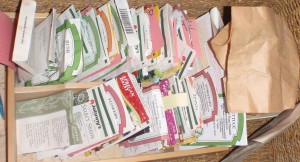
I could probably wall paper the house every year with the seed catalogs that come in the mail. Instead, I glance at them and “sort” them according to a few criteria. Most of them quickly end up in the waste basket, but I do prefer to buy most of my seed via mail. I get better information about the seeds and more choices in actual plants to grow this way, not just options about which company to buy from on the seed rack. Here is what I am looking for:
What types of seed are available?
- Is the seed clearly identified as open pollinated or hybrid? Heirloom is a catch phrase that I am beginning to find humorous, as dates from the 1850s – 1950s are listed. Surely, there were open pollinated seeds before that!
- Do the descriptions provide useful information, or are they just full of fun adjectives?
- Do the varieties have defining characteristics that interest me, including tolerance of certain weather conditions?
- Are the varieties unique from what is offered by other sources, not just renamed.
Where are the seeds produced?
- Does the company grow any of their own seeds?
- Do they say where they get their seeds?
- How similar to my own environment is the place where the seed is grown?
How close to me is the seed company?
- This affects how fast the seeds get to me.
- Besides convenience, less time in transit means less chance for exposure to damage from things like heat and moisture.
Is growing information organized and easy to reference?
- Are any specifics about growing conditions listed?
- Is it easy to note days until harvest?
- Are common cautions and problems listed?
How much marketing hyperbole and philosophical propaganda is there?
- Advertising seed qualities is useful, but I don’t need to wade through their moral perspectives while shopping.
- An attitude of moral superiority about their products often leads to justifying higher prices.
- The more hyperbole, the less I buy.

